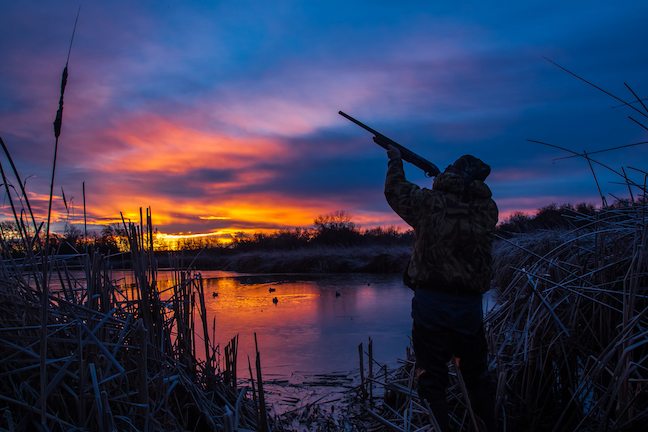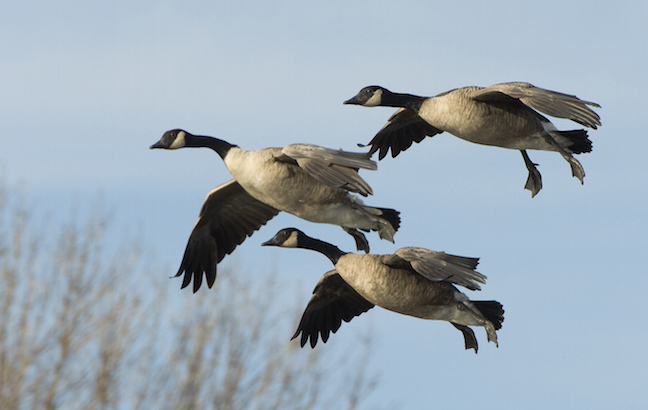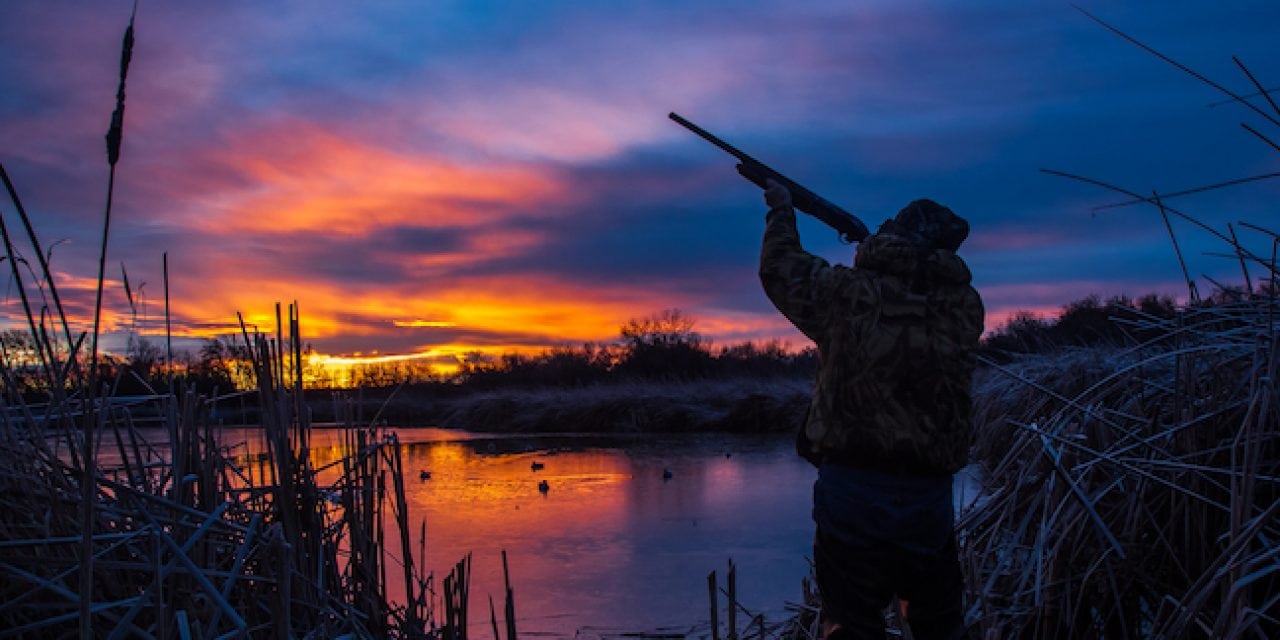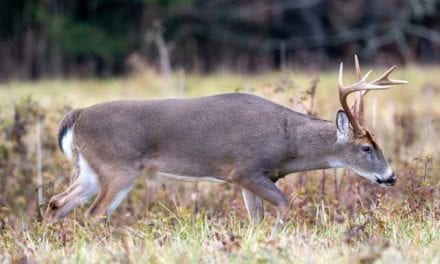There’s plenty of action for Missouri early waterfowlers before autumn’s main events.
Some Missouri waterfowl hunters are so inflexible, they won’t even consider loading up decoys and waders unless the wind is blowing a gale from the north and icicles decorate their moustaches.
They are entitled to their own notion of what constitutes hunting weather, but they are missing out on some of Missouri’s most enjoyable waterfowling experiences.

Here’s how and where to get in on our early waterfowling action in Missouri. (Shutterstock image)
One of those is being buzzed by bumblebee swarms of teal. Another is the opportunity to harvest stunning drake wood ducks. A third is bagging a liberal limit of Missouri’s resident giant Canada geese.
Yes, you can find green-winged teal in the Show Me State well into the regular duck season, but the flocks of 50 to 200 bluewings that swarm our marshes in September are long gone to Arkansas and Louisiana by Nov. 1.
Likewise, some of the thousands of wood ducks that nest or are hatched in Missouri each summer linger here into the early part of waterfowl season, but the first real cold front sends them packing, too.
You can harvest resident Canada geese throughout the regular goose season, but you are more likely to encounter smaller, migratory honkers that have moved into Missouri by then.
The only way to witness the grand passage of blue-winged teal is to take part in the early teal season.
If you really want to harvest an acorn-fed drake woody that is a delight on the table and provides the raw material for gorgeous dry flies, you need to focus on them first thing when the season opens.
And if you want to bag a goose big enough to feed the whole family at Thanksgiving or Christmas, the early Canada goose season is your best bet.
Here’s how and where to get in on our early waterfowling action.
GIANT CANADAS
Geese habitually hang out in the same spots. That can mean a rock dike or sandbar on the Missouri River, a lake on a CA or a stock pond on a farm.
The mowed areas on dams at CA lakes are popular goose gathering spots. Be sure to check area regulations on the MDC database before hunting on a CA. Some may have special restrictions.
Geese often wear out their welcome in suburban subdivisions, where their droppings make a stroll by the lake a gooey nightmare.
So, don’t be shy about knocking on doors to see if neighbors would mind you putting out the “unwelcome” sign by shooting a few winged poopers. They might even be able to offer insights about the birds’ daily routine.
Timing is critical to success with resident Canada geese. You have to figure out when they arrive at their favorite spots and get there before they do.
Also, geese are quick learners. Once a flock has been shot at in a particular location, the birds won’t be back any time soon. However, multiple flocks often use the same spot, so you might have several successful hunts before wearing a spot out.
Excellent concealment is a must for hunting resident giant Canada geese. Layout blinds grassed to match their surroundings are a good bet.

Timing is critical to success with resident Canada geese. (Shutterstock image)
Sometimes you can get away with simply donning a gillie suit, wrapping your shotgun with camo tape and lying in the grass near shore.
Leave your retriever at home, or keep it in your vehicle while hunting, and bring it out to retrieve downed birds when the shooting is done.
Canada geese love COE lakes, too, using dams, islands, and isolated coves to loaf and preen after feeding. One of the reasons the big birds love big water is because they can see trouble coming a long way off.
One way to foil this defense is to set up a well-camouflaged duck boat on points and pass-shoot the big gray birds. The other is to hide onshore near loafing areas.
Either strategy requires advance scouting to identify their loafing spots and travel routes. Geese don’t use the same spots every day so bring a good book or load up a few podcasts and pack a lunch. You might have to hunt the same spot two or three days in a row to score.
The early Canada goose season is Oct. 7-15 this year, with a daily limit of three and a possession limit of nine.
WOOD DUCKS
This year’s youth waterfowl hunt is set for Oct. 28 and 29 in the North and Middle zones, and Nov. 18 and 19 in the South Zone.
That’s early enough to find loads of woodies if you know where to look. Unlike puddle ducks, which mob big state wetland areas and federal refuges during the main duck season, woodies prefer places that are more intimate, more numerous and less crowded.
Literally hundreds of conservation areas have lakes, ponds, creeks or rivers where wood ducks nest in hollow trees.
Examples include Three Creeks CA in Boone County, Bois D’Arc CA in Greene County, Lamine River CA in Cooper County, Mussel Fork CA in Linn County, Swift Ditch Access in New Madrid County, and Thurnau CA in Holt County.
The MDC’s online CA database is the easiest way to find these areas, narrowing your search to hunting areas in your zip code.
Rebel’s Cove CA in Schuyler and Putnam counties is an excellent example of a CA that isn’t primarily a wetland area but offers great wood duck hunting opportunities all the same.
It encompasses nearly 5 miles of the Chariton River, including oxbow lakes and natural wetlands that add up to a wood duck paradise. You can enjoy a green-timber hunting experience there without driving 300 miles to Arkansas.
Another wood duck hunting hotspot that you probably never heard of is Ralph and Martha Perry Memorial CA in Johnson and Pettis counties. That area includes six miles of frontage on the Blackwater River, plus seven named wetlands totaling 768 acres.
I don’t mention these two areas in particular to encourage everyone to go there. That would be miserable. They are simply examples of the many CAs around the state that are sleeper duck-hunting areas. Dig into the MDC’s database to find one near you.
The interior portions of CAs along the Missouri and Mississippi rivers are another superb wood duck option. And don’t forget about Big Muddy National Fish and Wildlife Refuge, which has 16,700 acres of hunting land along the Missouri River between Kansas City and St. Louis.
Throw out half a dozen wood duck decoys in any of these places a half an hour before shooting light, and hide in adjacent vegetation. Chances are good that you will be visited by a family of wood ducks during the morning.
Wood ducks love to loaf and forage for acorns in borrow ditches along levees that border wooded streams. They often spend the night in trees bordering such spots and fly directly from their roost to the borrow ditch.
For some reason, they show a strong preference for spots where ditches make 90-degree bends. Hide yourself among the pin oak sprouts in such a place before dawn, and you can have action all morning long.
The far upper reaches of COE lakes — where the line between lake and feeder stream gets blurry — are great places to find wood ducks.
Pay special attention to lake arms with lots of standing dead timber or where pin oak trees border the water. Spinning-wing decoys are especially helpful to draw in woodies in the big expanses of COE lakes.
The limit on wood ducks is three daily and nine in possession.
EARLY TEAL
Missouri’s early teal season runs from Sept. 9-24 this year, the tail end just coming up as you read this. Early migrating teal are mostly the blue-winged variety, but on any given day, you might see more greenwings.
Regardless of species, teal are challenging targets because of their speed and aerobatic skills. You would do well to triple your normal lead when pass-shooting teal.
Neither teal species is much larger than a pigeon, so relatively light loads (No. 4 or No. 6 steel) and quick-handing, small-gauge scatterguns are in order. You don’t need lots of decoys.
A dozen green-winged teal decoys fit nicely in a day pack and, when combined with a spinning-wing decoy, are more than enough to attract the attention of passing teal. Teal aren’t especially wary. If you sit still, you can fool them by hunkering down in relatively sparse vegetation.
Be ready for teal to execute spectacular maneuvers when you stand up to shoot. They can go from zero to 60 in about two seconds and practically turn themselves inside out doing U-turns.
Don’t despair if a flock comes and goes so fast that you can’t even get off a shot. Chances are good that they will circle back for another look. Just as often, though, they will zip in undetected and drop into the decoys before you know they’re there. Jump-shooting teal is fair play with these speedsters.
Almost anyplace that has a few acres of water 3 to 18 inches deep can attract teal. However, they have a strong preference for places with lots of open space. The upstream ends of sandbars on the Missouri and Mississippi rivers meet this criterion.
So do flooded fields of foxtail, smartweed or other native vegetation on wetland areas managed by the Missouri Department of Conservation. Bob Brown, Nodaway Valley, Grand Pass, Fountain Grove, Eagle Bluffs, Ted Shanks, B.K. Leach, Marais Temps Clair, Columbia Bottoms, Duck Creek, Otter Slough, Ten Mile Pond, Four Rivers, Schell-Osage and Montrose Conservation Area all are excellent teal areas.
Lakes owned by the U.S. Army Corps of Engineers are great potential teal spots, too. The backs of coves will be your best bets on Corps land, but don’t neglect isolated ponds, wetlands and other small patches of water away from the main lakes. The key is finding shallow water. Teal don’t need more than a puddle to make them happy.
The limit on teal during the early hunt is six blue-winged, green-winged or cinnamon teal in the aggregate daily, and 18 in possession. Even though cinnamon teal are legal game in Missouri, you aren’t likely to see any. Including them in the bag limit helps hunter errors.
The post Early Waterfowl Action Tips in Missouri appeared first on Game & Fish.
















